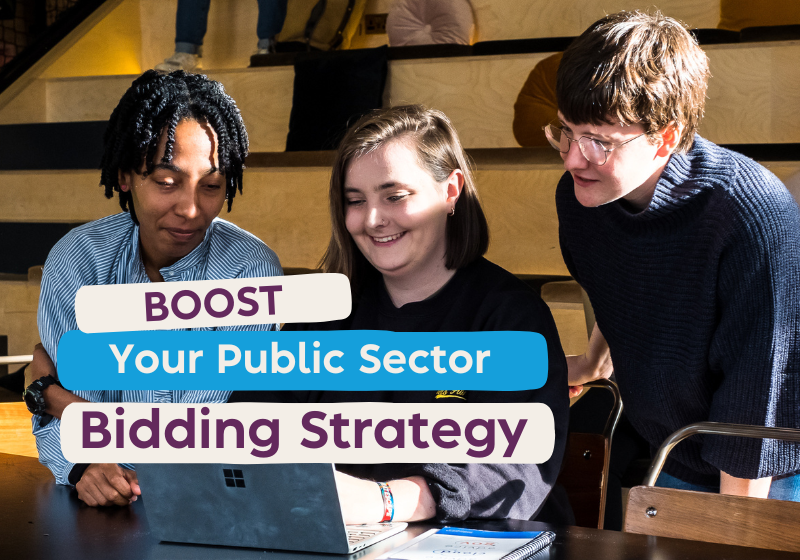The Basics
First off, lets cover what we mean by “Public Sector Bidding”. In short, it’s what we call the process that suppliers to the public sector (we’re talking about the UK Government market here) have to follow in order to throw their hat in the ring for opportunities. We call it bidding, or someone submitting ‘a bid’, because these responses will be evaluated and competing against other submissions for the contract being advertised.
There are different ways that a bid will be evaluated, and also different ways in which this bid will be structured, but the intent of it all is the same: For potential suppliers to outline how they can meet the criteria outlined by the buyer, and for this to be evaluated to find the best possible solution out of all of those who applied.
So what does a public sector bid look like?
UK public sector procurement usually follows a process called Further Competition. Further Competition is the process of inviting multiple suppliers to compete for a contract. Instead of directly awarding a contract to a single supplier, further competition allows for a wider evaluation of potential suppliers’ offerings. It’s aim is to ensure transparency and fairness in the procurement process by providing an equal opportunity to bid. It also allows buyers to assess a big range of potential solutions, encouraging competition and good value-for-money options.
In the UK public sector market, we often see most bids contain three important sections. Quality, Technical, and Pricing – often called QTP. These sections are described as:
- Quality: This assesses the overall quality of the proposed solution, including its effectiveness, reliability, and suitability for the buyer’s needs. Quality criteria may include factors such as innovation, performance, and compliance with specifications. This is where suppliers usually have to demonstrate their prior work (hopefully with the public sector!), via case studies or project history.
- Technical: This evaluates the technical aspects of the bid, such as the proposed approach, methodology, technical expertise, and the bidder’s capability to deliver the solution successfully. Technical criteria may include considerations like scalability, interoperability, and security. Suppliers here have to show how what they can deliver matches the needs and requirements of the posted opportunity.
- Pricing: This involves evaluating the cost of the proposed solution, including both initial costs and ongoing expenses. Pricing criteria assess the competitiveness, transparency, and value for money offered by the bid.
Alongside these areas, bidders will have to show that they can meet all requirements, and follow the regulations in place. In these three areas, you should also be explaining the social value your company can bring to the public sector and UK citizens. It can take some getting use to when adding this into bids, especially if limited by word counts. However, we’ve got some useful guidance about social value and public sector bids right here – or grab your own copy of our handy infographic on the topic.
How are bids evaluated?
Public sector bids, as we see them, are usually evaluated using M.A.T., which was until recently M.E.A.T. This stood for Most Economically Advantageous Tender. Which meant buyers would evaluate a bid on whether it was fit for purpose, but also the Quality, Technical, innovation, and sustainability/social value of a solution within the bid.
Now, since the roll-out of the Procurement Act 2023, which is introduced in October 2024 properly, we’ve seen the change to M.A.T. Which means Most Advantageous Tender. This doesn’t mean we’re forgetting about pricing, though! It means that the economic benefits aren’t weighed more highly than benefits such as social value. This is because things like social value are a bit harder to quantify than costs, so making the two have an equal footing helps. It means that the chosen option might not be the cheapest, but supports local communities and improves user wellbeing for example.
Where do I find public sector opportunities?
This is a brief introduction to the best places and most common ways to find where buyers will make their opportunities available to bid on, for a more in-depth article just click here.
The most simple way to find Prior Information Notices (PINs) is via portals such as:
- England – Contracts Finder
- Scotland – Public Contracts Scotland
- Wales – Sell2Wales
- Northern Ireland – eTendersNI
PINs are what buyers publish to publicly display their intention to contract in the future. These notices outline a future contract coming up for a bidding window. This could be a brand new deliverable wanted by a public sector organisation, or a current contract coming to its end and up for renewal. They’ll detail when it opens for applications, what is planned to be in the scope for the opportunity, and the value too.
For bigger value contracts, you’ll want to look at the Find a Tender service (FTS) too. This replaced OJEU (the European version) after Brexit.
Through procurement frameworks
Frameworks, and Dynamic Purchasing Systems, are agreements that pre-establish contracts terms and requirements before opportunities are posted. Usually limited to a certain amount of suppliers, these routes to market make sure that everyone on the framework has already met the criteria and has been effectively vetted. Frameworks such as Network Services or Digital Capability For Health are capped to still create competition. However, others such as G-Cloud and Digital Outcomes aren’t at all, and just provide access to an easier route to procurement.
Usually, these frameworks also operate using Further Competition (FYI G-Cloud doesn’t, but that’s a whole different thing!), and buyers will post Invitations to Tender (ITTs) through these routes – only for those listed on the frameworks. Interested suppliers will then bid and respond to these ITTs.
Here’s a useful infographic for ways we recommend keeping an eye on opportunities.


